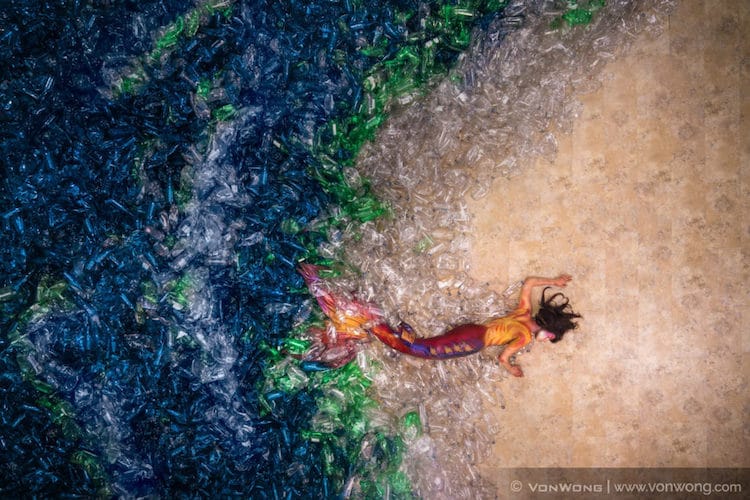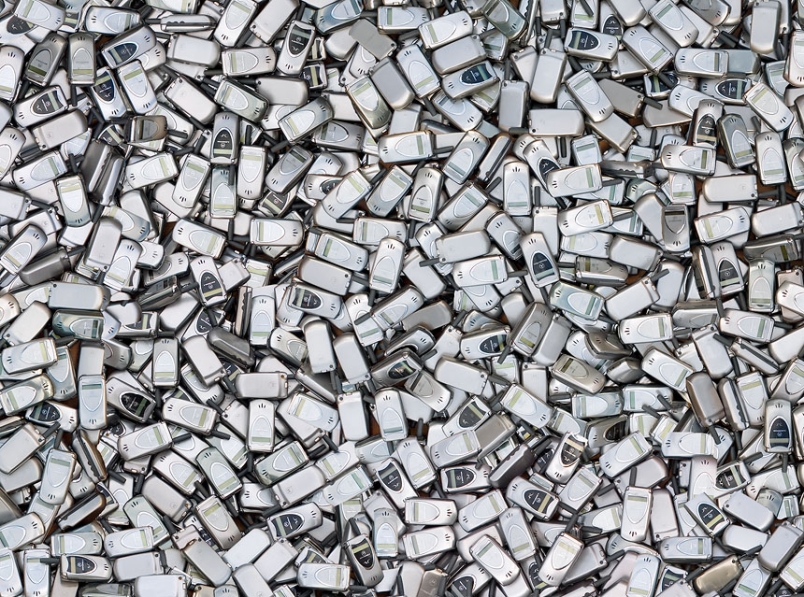Some Works of Art Can Be Ephemeral Environmental and Found

Photo: Benjamin Von Wong
Earlier this year, the Eu voted for a sweeping ban on unmarried-use plastic in an attempt to reduce sea plastic pollution. But information technology's non just politicians that are doing their part to protect our planet—artists are working just as hard to raise awareness of environmental problems, evoke change, and document the beauty of the globe before it'southward too late.
The ecology art move emerged in the 1960s and early 1970s and primarily celebrates the artist'south connection with nature. Pioneers of the move such as Nils-Udo became famous for creating site-specific sculptures and installations from found natural materials, and so documenting his works with photography. While earlier artists such as Udo celebrate the beauty of nature, many of today's artists are using a wide range of media, techniques and styles to address social issues and the negative touch we as homo beings are having on our planet.
Notice half-dozen of the virtually notable ecology artists of our fourth dimension.
Nils-Udo

German creative person Nils-Udo celebrates the beauty of nature by working with establish materials—such equally leaves and branches—to create stunning, site-specific works. He'south known for creating "utopias" that transform the country into mysterious, dreamlike realms. From delicately arranged petals scattered on the surface of a pond, to spectacular nests formed from twigs, leaves, and wildflowers, his works look as though they were created past busy woodland fairies or creatures of the forest.
His artist statement reads: "By installing plantings or by integrating them into more complex installations, the work is literally implanted into nature. As a office of nature, the work lives and passes away in the rhythm of the seasons."
Andy Goldsworthy
British sculptor, lensman, and environmentalist Andy Goldsworthy is known for his site-specific land art made from natural, institute materials. He crafts his installations out of rocks, water ice, leaves, or branches, so carefully documents how the imperceptible installations alter and wither over fourth dimension. "Information technology's not nigh art," he explains. "It'southward just about life and the need to sympathize that a lot of things in life do not last."
Richard Shilling
Inspired by the work of Goldsworthy, British artist Richard Shilling uses natural materials gathered from the environment to create outdoor sculptural installations. Exploring form and colour, his most recognizable works include his stained glass-like sculptures made from colorful leaves, and his stacked rock totems. He tells My Modern Met, "Nature art is but only one way of expressing the joy of feeling at one with the surroundings."
Agnes Denes

Hungarian conceptual artist Agnes Denes is frequently referred to every bit "the grandmother" of the early environmental art movement. She emerged during the 1960s and '70s and created many surround-inspired, site-specific pieces. Her about famous work, titled Wheatfield, a Confrontation, was created during a four-month menses in the leap and summer of 1982. With the support of the Public Art Fund, Denes planted a field of gilt wheat on two acres of landfill most Wall Street in lower Manhattan.
Now based in New York, Denes continues to piece of work in a wide range of media. From poetry and writing to complex mitt and computer-rendered diagrams, the artist explores the relationship between nature and the urban environment.
Denes' upcoming show at The Shed gallery in 2019 will be her first solo exhibition at a major New York establishment.
Chris Jordan

Seattle-based artist and lensman Chris Jordan exposes consumerist civilization and uses shocking images of plastic waste to remind us about how we are destroying our planet. In his series titledIntolerable Dazzler: Portraits of American Mass Consumption, he explored some of America'due south shipping ports and industrial yards, where he captured colossal piles of discarded appurtenances, such every bit cellphones and computer parts.
"I am appalled by these scenes, and withal likewise drawn into them with awe and fascination," reveals the artist. "The immense scale of our consumption tin appear desolate, macabre, oddly comical and ironic, and even darkly beautiful; for me its consequent characteristic is a staggering complexity."
In his recent short film, ALBATROSS, Jordan reveals the gut-wrenching ecology tragedy of tens of thousands of albatross chicks. On a remote island in the middle of the bang-up Pacific, Chris and his filming team witnessed cycles of birth, life, and finally death caused past plastic pollution. The shocking footage shows the birds lying dead on the footing with their bodies filled with plastic.
Benjamin Von Wong
Photographer Benjamin Von Wong creates cute, thought-provoking images that create awareness of issues such as climate change and plastic pollution in our oceans. His high-concept projects involve innovative use of materials, which is particularly true in one of his latest projects that focuses on e-waste product. By partnering with Dell and Wistron Greentech, Wong acquired the estimated amount of electronic waste created past an boilerplate denizen of the U.s. in one lifetime and turned it into stunning, post-apocalyptic imagery.
Learn more well-nigh the project below.
Related Articles:
Spectacular Works of Land Fine art Celebrate the Beauty of Nature
Unexpected Land Art Beautifully Formed in Nature
Interview: Imperceptible State Art by a Man Who Discovered His Creativity in Nature
4,100 Pounds of E-Waste Are Transformed Into Post-Apocalyptic Landscapes
Amazingly Creative Examples of Environmental Art
Source: https://mymodernmet.com/environmental-art/
0 Response to "Some Works of Art Can Be Ephemeral Environmental and Found"
Post a Comment